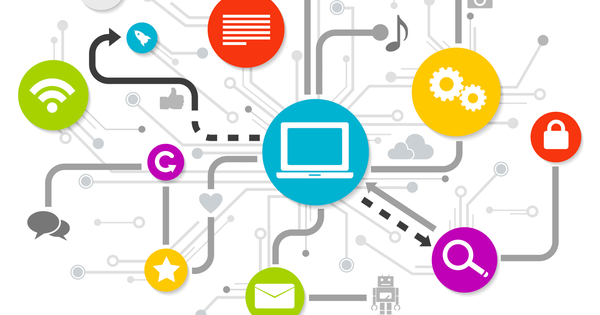What is Figma? Benefits and Advantages of Figma
Figma is a prominent cloud-based UI/UX design tool. Using Figma, designers can create high-quality products in a short time. In this article, TipsMake will help you learn more about Figma from its history to the benefits it brings.
What is Figma?
Figma is a powerful, cloud-based online vector graphics and user interface design tool. It is widely used in UI/UX design for web and mobile applications, as well as in creating other designs such as social media posts, flyers, posters.
The great thing about Figma is that it doesn't require any complicated software installation; all you need is a web browser and an internet connection to start designing. This makes Figma accessible to a wide range of users from beginners to industry experts.

Figma is a software that includes many powerful design tools on a web platform.
History of Figma
2012: Figma began development with the idea of creating a browser-based platform that would allow users to express their creativity in a variety of ways.
Late 2015: Figma launches a beta version for registered users to try out. This is the first step in introducing Figma to the public.
September 2016: Figma was officially launched and began to be widely used. Since then, it has become an important design tool in the design community.
October 2019: Figma Community is introduced, allowing designers to publish their work for others to view and remix.
April 2021: Figma develops FigJam, a digital whiteboard tool that allows users to add notes, drawings, and emojis to collaborative projects. FigJam enhances interaction and creativity in design projects

Figma allows users to use tools in collaborative projects to take notes
Outstanding advantages of Figma
Figma is not just a regular design tool but also brings many outstanding advantages compared to other software. Below are some outstanding advantages that Figma possesses.
Allows multiple users to work together in real time: Users can instantly view changes, provide feedback, and discuss without having to send design files back and forth. This enhances communication and saves time, while improving team productivity.
Integration with other tools: Figma supports integration with many different tools and services such as: Slack, JIRA, Trello, helping users easily manage projects and communicate with team members.
High-quality file export: Figma supports exporting files in many formats such as JPG, PDF, SVG, PNG, with sharp image quality.
Convenient in sending and receiving feedback: Customers can easily give feedback directly on the design without having to download or use other tools

Figma is a suitable tool for teamwork, members can interact with each other
Popular Applications of Figma
Below are some popular applications where Figma is commonly used.
User Interface (UI) and User Experience (UX) Design:
Figma is widely used for designing user interfaces and experiences for websites and mobile apps. It helps create sketches, interface layouts, and prototypes that help visualize the product visually.
Prototyping and modeling:
Figma's prototyping feature allows users to create interactive mockups without any programming knowledge. Designers can easily bring their designs to life by adding interactions and motion.
Marketing and communication design:
In addition to UI/UX design, Figma is also used to create media products such as advertising banners, infographics, and social media posts. By leveraging the prototyping capabilities and asset library, users can quickly create engaging content in no time.
Benefits of designing with Figma
Figma offers more than just design tools. Here are some of the benefits of designing with Figma.
Save time: Online collaboration allows multiple people to work at the same time, reducing waiting time and sending files back and forth. In addition, plugins and resource libraries help optimize the design process, creating the effect of shortening project completion time.
Improved collaboration: Figma allows for continuous communication, feedback, and discussion throughout the design process.
Ensure product quality: Thanks to its prototyping and modeling capabilities, Figma helps ensure product quality before development.
Easy feedback: Figma allows users to easily share design files with colleagues and clients. This helps get faster and more accurate feedback, thereby improving the product in the best way.

What is Figma for?
Figma isn't just for designers, it can serve many different roles in the product development process. Here are some roles where Figma is a good fit.
- UI/UX Designers: For UI and UX designers, Figma is an indispensable tool.
- Developers: Developers can also leverage Figma to get information about product design and architecture. Sharing design documentation directly from Figma helps developers better understand how the product works and reduces confusion during development.
- Product Management: Use Figma to track design progress and ensure that the product meets requirements.
- Marketers: Prototyping features and easy sharing capabilities help marketers produce content quickly and efficiently.
Compare Figma with adobe XD
When it comes to user interface design, Figma and Adobe XD are two of the most popular tools. However, each tool has its own advantages and disadvantages.
How to Sign Up and Use Figma
Just follow the steps below to start signing up and using Figma.
- Sign up for Figma: Open your browser and go to www.figma.com
- Sign up for an account: Click the "Get started for free" button in the upper right corner of the screen. You can sign up with your Google account or email.
- Fill in information: Enter full name, email address, password and organization name (if any).
- Verify account: Check your email to confirm your account by clicking on the activation link sent to your inbox
How to use Figma for developers
Figma is not just for designers, it also helps developers in their product development process. Here's how developers can take advantage of Figma.
1. View the Inspect Tab
Figma lets developers view properties of elements like size, color, spacing, and font. You can export this data to formats like PNG, SVG, or as code in CSS, Swift, or XML.
2. Select Element
Select Element directly: Click on an element to view parameter details.
Select Element in layer: Use Command + click on the desired element.
Show Layer Selector: Right-click on the element to display the Select Layer panel.
3. Export Assets
Developers can export CSS directly from design files and are compatible with iOS and Android operating systems:
Export Individual Assets: Select and click the export button.
Export all Assets: Use the key combination Control/Command + Shift + E to open the Export Panel.
4. Check distance and size
- Select code panel
- Select the element you want to measure
- Move the mouse pointer over another layer to see the parameters more intuitively
5. Find the key ingredients
- Right click on the component.
- Select Main Component and Go to main component to locate the main component.
6. Search for layers
Use the Find/Focus plugin in Figma to search for layers by entering keywords.
7. View design simulation
Use Prototypes to see how users interact with your design.
Figma will display frames with connected prototypes.
Conclude
So we can see that Figma has proven its power and utility in the design field. With great collaboration capabilities, ease of use and flexibility, Figma has become a favorite tool for many designers and programmers. Hopefully, through this article of TipsMake, you will have an overview of Figma and the benefits it brings to design work.
You should read it
- The most useful free Figma plugins
- 16 Useful Figma Plugins Free Downloadable
- How to create an engaging presentation using Figma
- Figma can use your content to train AI: How to prevent it?
- 9 best free Figma courses
- 11 useful tips for a productive Figma workflow
- How to convert any website into a Figma design
- How to create a master template for presentations in Figma
May be interested
- What is Websocket? Outstanding advantages and disadvantages of Websocket
 websocket is a type of technology that supports two-way communication between client and server. this technology uses tcp protocol to connect information together in the internet environment.
websocket is a type of technology that supports two-way communication between client and server. this technology uses tcp protocol to connect information together in the internet environment. - What is TCP? Advantages and How Does it Work?
 tcp is an important network protocol used in transmitting data over a network.
tcp is an important network protocol used in transmitting data over a network. - What is Selenium? Overview of information you need to know about Selenium
 selenium is a free, open source, cross-browser, cross-platform automated testing toolkit for web applications.
selenium is a free, open source, cross-browser, cross-platform automated testing toolkit for web applications. - What is Microsoft Access? Instructions on how to use Microsoft Access
 microsoft access is a relational database management system that enables users to store and manage information.
microsoft access is a relational database management system that enables users to store and manage information. - What is Comodo Positive SSL? Comparison between Positive SSL and Essential SSL
 comodo positive ssl is a type of ssl security certificate provided by sectigo, formerly known as comodo.
comodo positive ssl is a type of ssl security certificate provided by sectigo, formerly known as comodo. - What is Subnetting and its advantages and disadvantages?
 subnetting, also known as 'network fragmentation', is the process of dividing a large network into several smaller subnets.
subnetting, also known as 'network fragmentation', is the process of dividing a large network into several smaller subnets.






 Figma - Free Multimedia Design Tool
Figma - Free Multimedia Design Tool 11 useful Figma shortcuts to work faster
11 useful Figma shortcuts to work faster The most useful free Figma plugins
The most useful free Figma plugins 16 Useful Figma Plugins Free Downloadable
16 Useful Figma Plugins Free Downloadable How to create an engaging presentation using Figma
How to create an engaging presentation using Figma